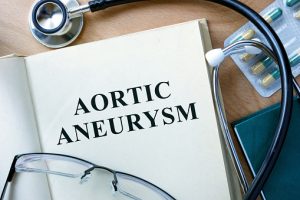 Virtual reality images can now be used to help improve treatment of abdominal aortic aneurysms due to a technology developed by a group of experts at the University of Montreal Hospital Research Centre.
Virtual reality images can now be used to help improve treatment of abdominal aortic aneurysms due to a technology developed by a group of experts at the University of Montreal Hospital Research Centre.
Abdominal aortic aneurysms are serious. If you have an abdominal aortic aneurysm it means the lower part of your aorta is enlarged. The aorta is the major blood vessel supplying blood to the body. The aorta runs from your heart through the middle of your chest and abdomen. A ruptured abdominal aorta can lead to life-threatening bleeding.
Advertisement
Aortic aneurysms in the United States caused just over 10,000 deaths in 2009, according to the Centres for Disease Control and Prevention. Although we can’t say for certain why, about two-thirds of people who have an aortic problem are male. The size and rate at which the abdominal aortic aneurysm grows determines the treatment. With some patients emergency surgery is the obvious approach.
Improving treatment of abdominal aortic aneurysm using virtual reality
 One of the biggest challenges in addressing abdominal aortic aneurysms has been the inability to clearly see the area that needs to be treated. Using virtual reality is a way to significantly improve visibility.
One of the biggest challenges in addressing abdominal aortic aneurysms has been the inability to clearly see the area that needs to be treated. Using virtual reality is a way to significantly improve visibility.
Virtual models can now be created in the angiography room with the approach developed by the researchers in Montreal. This allows for a more detailed look at the abdominal aorta. Even though there have been advances in imagery that improved surgery in recent years, the team in Canada indicated that they wanted to develop new software to maximize images from ultrasound scanners, as well as magnetic resonance imaging technologies so that doctors can provide personalized treatment to patients.
Right now, an abdominal ultrasound can detect patients at risk of aneurysm rupture. Surgery is typically recommended when it is beyond five centimetres for women and 5.5 centimetres for men. Since surgery for abdominal aortic aneurysm is risky, the researchers want to “refine” screening to provide the best approach possible for patients who require surgery.
When it comes to surgery the key is to avoid rupturing the small balloon that is formed by the abdominal aortic aneurysm. Currently, there are two options for surgeons – open surgery to replace the diseased section, or a procedure called endovascular grafting. This involves a catheter being inserted into the groin to deliver a stent-graft through blood vessels to the aneurysm. While the second option is less invasive, it is not suitable for all patients.
Risk factors and symptoms for abdominal aortic aneurysms
 Aneurysms can develop slowly over a very long period of time, or in some cases, over years and with no symptoms. For some people symptoms appear quickly, especially in cases where the aneurysm grows and expands rapidly, tears or leaks blood.
Aneurysms can develop slowly over a very long period of time, or in some cases, over years and with no symptoms. For some people symptoms appear quickly, especially in cases where the aneurysm grows and expands rapidly, tears or leaks blood.
Here are some possible symptoms of rupture:
- Pain in the back or abdomen
- Pain in the groin, buttocks or legs
- Dizziness and/or fainting
- Clammy skin
- Nausea and vomiting
- Rapid heart rate
- Shock
Many people who experience sudden symptoms are surprised when they are officially diagnosed with abdominal aortic aneurysm; however, there are risk factors for the condition.
As mentioned above, men are in a higher risk category than women when it comes to abdominal aneurysm. Smoking has been linked to an increased risk of all types of aneurysms, including brain and abdominal. The longer you have smoked, the higher your risk will be.
Additionally, people who have a condition known as Atherosclerosis, which is the build-up of fat and other substances that can damage the lining of a blood vessel, are at increased risk of an aneurysm. Family history also plays a role in whether or not you are more prone to aneurysms.
Causes that lead to abdominal aortic aneurysms
No exact cause has been pinpointed, but medical researchers do know that certain lifestyle choices can contribute to abdominal aortic aneurysm. Let’s take tobacco as an example. Smoking causes build-up of fatty plaques in arteries and has been linked to high blood pressure. Data shows that if you already have a small aneurysm, smoking can cause it to grow much faster by further damaging your aorta.
Another big cause is hardening of the arteries. Again, making healthy choices can help you avoid this problem. Hardening of the arteries can occur when cholesterol levels are too high due to poor diet. In other words, a diet that is full of high saturated and trans fats. Alcohol use, lack of exercise and obesity can also lead to hardening of the arteries.
Although rare, abdominal aortic aneurysms can be caused by an infection or inflammation. Both of these conditions can weaken sections of the aortic wall.
As people age, there is a higher chance of abdominal aortic aneurysm, yet younger people still get these aneurysms if the risk factors, including poor lifestyle, are dominant.
Diagnosis and remedies for abdominal aortic aneurysms
 The obvious approach to avoid abdominal aortic aneurysm is to live a healthy lifestyle. Avoid smoking, excessive amounts of alcohol and eating fatty foods. Including a regular exercise routine in your schedule is a good idea and so is checking your blood pressure. If you have high blood pressure, make sure you discuss it with your doctor to get it under control. Relieving stress and anxiety can also help. It can strengthen arteries that may have been weakened over time. Exercises, such as meditation and yoga can also help release some of your daily stress.
The obvious approach to avoid abdominal aortic aneurysm is to live a healthy lifestyle. Avoid smoking, excessive amounts of alcohol and eating fatty foods. Including a regular exercise routine in your schedule is a good idea and so is checking your blood pressure. If you have high blood pressure, make sure you discuss it with your doctor to get it under control. Relieving stress and anxiety can also help. It can strengthen arteries that may have been weakened over time. Exercises, such as meditation and yoga can also help release some of your daily stress.
Advertisement
Since people over the age of 60 are at a higher risk of developing the condition, they can consider going through a screening procedure on a regular basis to put their minds at ease. There is a health taskforce in the U.S. called Preventative Services that recommends men aged 65 to 75 who have ever smoked get an ultrasound screening for abdominal aortic aneurysms, even if they don’t have any symptoms.
A normal aorta is about one inch or two centimeters in diameter. When an aneurysm stretches the aorta beyond a safe margin, it can burst or rupture. This is when severe internal bleeding occurs, which can cause shock or possibly death. Abdominal aortic aneurysm can cause other health problems. One serious health implication is called embolization. This is when clots of debris from inside the aneurysm travel, leading to other organs in the body. If one of the blood vessels become blocked it can cause severe pain. In some situations, it can lead to loss of limbs.
Early diagnosis and careful, individualized treatment is key to a good recovery for those who suffer from abdominal aortic aneurysm. The team of researchers in Montreal believe their virtual reality imaging approach is a step in the right direction in terms of targeted treatment for patients.
